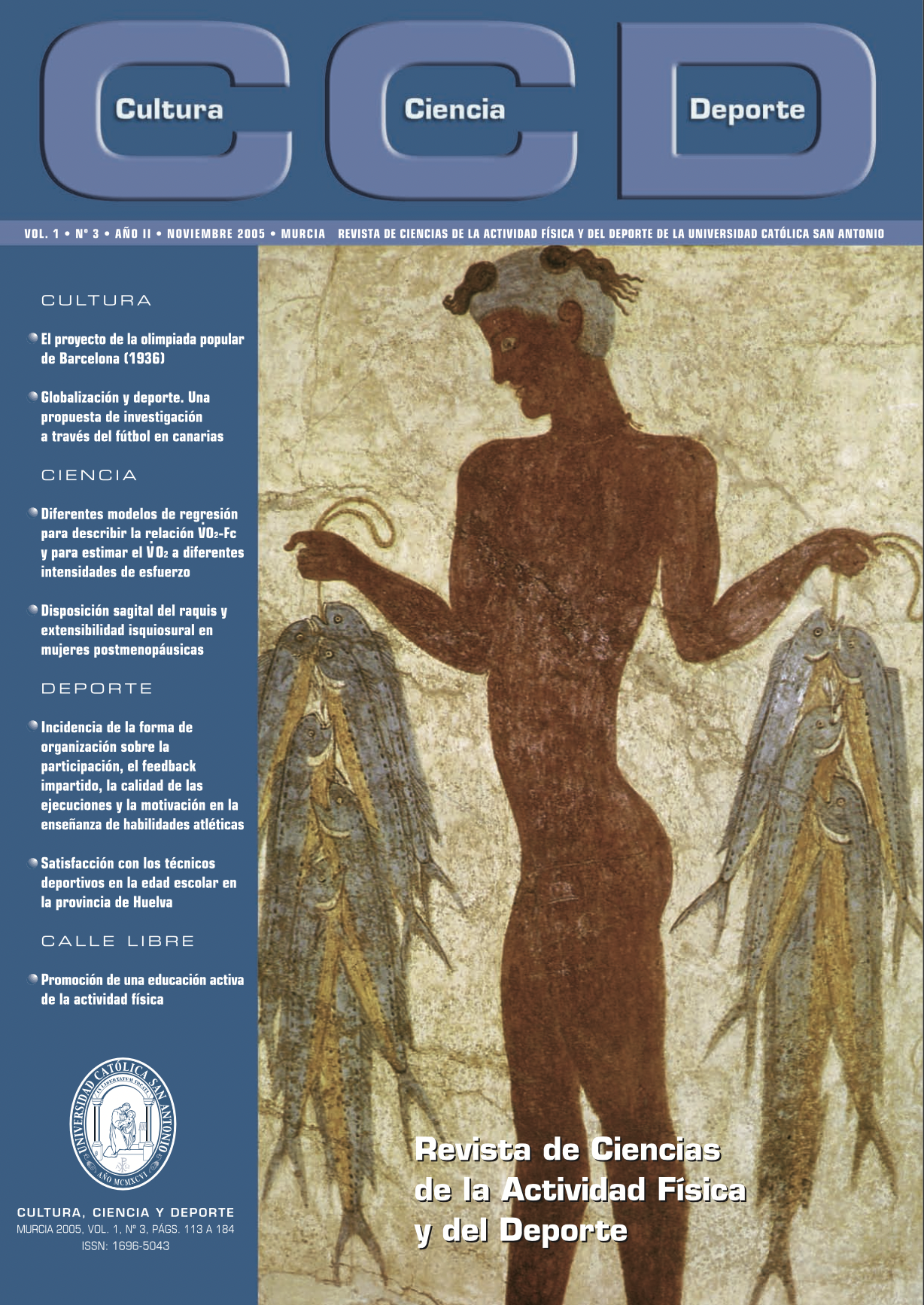Incidencia de la forma de organización sobre la participación, el feedback impartido, la calidad de las ejecuciones y la motivación en la enseñanza de habilidades atléticas. (Effect of the form of organization on the participation, feedback distributed, the quality of execution and the motivation on the education of athletic abilities).
DOI:
https://doi.org/10.12800/ccd.v1i3.117Abstract
El objeto de esta investigación es analizar la influencia de dos modalidades de organización (grupos en hilera y grupos en circuito) sobre variables del proceso de enseñanza-aprendizaje. Se realizó un diseño cuasi-experimental intragrupo con un grupo de quince niños de una edad media de 12,3 ± 0,9 años. Se impartieron seis sesiones de enseñanza de tres disciplinas atléticas (técnica de carrera, salto de altura y lanzamiento de disco). La variable independiente objeto de estudio fue la forma de organización (grupos en hilera y grupos en circuito) y las variables dependientes fueron la cantidad de práctica, el feedback impartido, la calidad de las ejecuciones y la motivación. Los resultados obtenidos indican que: a) el tiempo invertido en la preparación inicial de la sesión y colocación del material (tiempo de organización) es mayor en la forma de organización con circuitos; b) el tiempo de organización total de la sesión varía, en aquellas sesiones organizadas con filas, en las que hay cambios en la disposición del material para los ejercicios, sobre aquellas en las que no lo hay (tiempo de organización un 20% mayor); c) el tiempo de ejecución motora y el número de repeticiones realizadas por ejercicio son mayores en la organización mediante circuitos que en la organización mediante hileras en las tres modalidades atléticas practicadas (35,1% frente a 17,8%); d) el feedback de tipo masivo-general y masivo-específico predominan en la organización en circuitos; mientras que el feedback de tipo individual-general e individual-específico predominan en la organización en hileras; e) la calidad de las ejecuciones es mayor en la forma de organización en hileras que en la forma de organización en circuitos (60% frente a 55,1%). A partir de los datos obtenidos, se deduce que dependiendo de cuáles sean los objetivos y contenidos de aprendizaje en las habilidades atléticas, será más adecuado utilizar un tipo de organización u otro.
Palabras clave: Eficacia en la enseñanza, estructura de las tareas, iniciación deportiva, atletismo.
===
Abstract
The purpose of this paper is to analyze the influence of two modalities of organization (groups in row and groups in circuit) on variables of the education-learning process. An cuasi-experimental design was made intragroup with a group of fifteen athletes of an average age of 12.3 ± 0.9 years. Six sessions of education of three athletic disciplines were distributed (technical of race, high jump and disc launching). The independent variable study object was the dependent form of organization (groups in row and groups in circuit) and variables were the amount of practice, feedback distributed, the quality of the executions and the motivation. The obtained results indicate that: a) the time inverted in the initial preparation of the session and positioning of the material (time of organization) is greater in the form of organization with circuits; b) the time of total organization of the session varies, in those sessions organized with rows, in which there are changes in the disposition of the material for the exercises, on those in which there is no it (time of organization a greater 20%); c) the motor run time and the number of repetitions made by exercise are greater in the organization by means of circuits that in the organization by means of rows in the three practiced athletic modalities (35.1% as opposed to 17.8%); d) feedback of type massive-specific massive-general and predominates in the organization in circuits; whereas feedback of type individual-specific individualgeneral and, predominates in the organization in rows; e) the quality of the executions is greater in the form of organization in rows that in the form of organization in circuits (60% as opposed to 55.1%). From the collected data, it is deduced that depending on which are the objectives and contents of learning in the athletic abilities, more will be adapted to use a type of organization or another one.
Key words: Teaching effectiveness, task structure, initial stage, athletics.
Downloads
How to Cite
Issue
Section
License
The authors who publish in this journal agree with the following terms:
- The authors retain the copyright and guarantee the journal the right to be the first publication of the work as well as licensed under a Creative Commons Attribution License that allows others to share the work with recognition of the authorship of the work and the initial publication in this journal.













